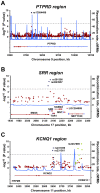A genome-wide association study identifies susceptibility variants for type 2 diabetes in Han Chinese
- PMID: 20174558
- PMCID: PMC2824763
- DOI: 10.1371/journal.pgen.1000847
A genome-wide association study identifies susceptibility variants for type 2 diabetes in Han Chinese
Abstract
To investigate the underlying mechanisms of T2D pathogenesis, we looked for diabetes susceptibility genes that increase the risk of type 2 diabetes (T2D) in a Han Chinese population. A two-stage genome-wide association (GWA) study was conducted, in which 995 patients and 894 controls were genotyped using the Illumina HumanHap550-Duo BeadChip for the first genome scan stage. This was further replicated in 1,803 patients and 1,473 controls in stage 2. We found two loci not previously associated with diabetes susceptibility in and around the genes protein tyrosine phosphatase receptor type D (PTPRD) (P = 8.54x10(-10); odds ratio [OR] = 1.57; 95% confidence interval [CI] = 1.36-1.82), and serine racemase (SRR) (P = 3.06x10(-9); OR = 1.28; 95% CI = 1.18-1.39). We also confirmed that variants in KCNQ1 were associated with T2D risk, with the strongest signal at rs2237895 (P = 9.65x10(-10); OR = 1.29, 95% CI = 1.19-1.40). By identifying two novel genetic susceptibility loci in a Han Chinese population and confirming the involvement of KCNQ1, which was previously reported to be associated with T2D in Japanese and European descent populations, our results may lead to a better understanding of differences in the molecular pathogenesis of T2D among various populations.
Conflict of interest statement
The authors have declared that no competing interests exist.
Figures



References
-
- Zimmet P, Alberti KG, Shaw J. Global and societal implications of the diabetes epidemic. Nature. 2001;414:782–787. - PubMed
-
- Stumvoll M, Goldstein BJ, van Haeften TW. Type 2 diabetes: principles of pathogenesis and therapy. Lancet. 2005;365:1333–1346. - PubMed
-
- Ledermann HM. Maturity-onset diabetes of the young (MODY) at least ten times more common in Europe than previously assumed? Diabetologia. 1995;38:1482. - PubMed
-
- Maassen JA, LM TH, Van Essen E, Heine RJ, Nijpels G, et al. Mitochondrial diabetes: molecular mechanisms and clinical presentation. Diabetes. 2004;53(Suppl 1):S103–109. - PubMed
-
- Fajans SS, Bell GI, Polonsky KS. Molecular mechanisms and clinical pathophysiology of maturity-onset diabetes of the young. N Engl J Med. 2001;345:971–980. - PubMed
Publication types
MeSH terms
Substances
LinkOut - more resources
Full Text Sources
Other Literature Sources
Medical

